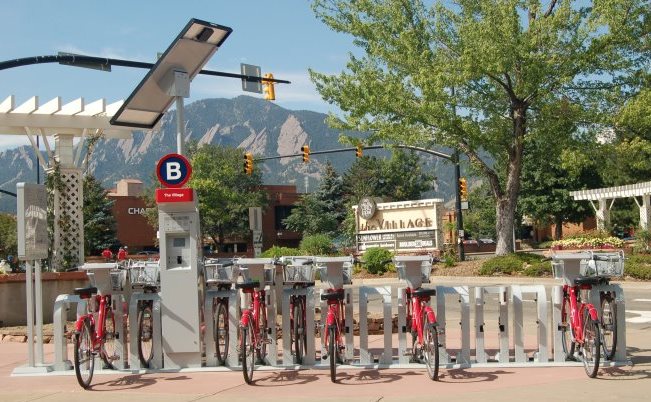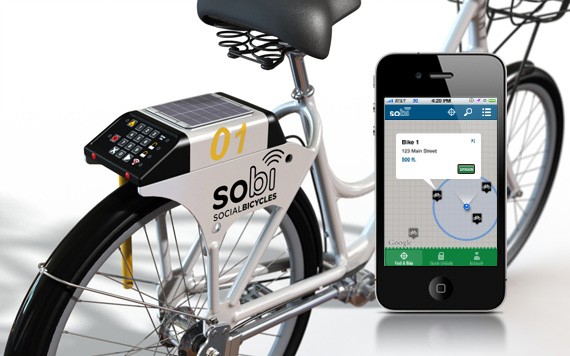Bikeshare initiatives have developed significantly since their introduction in Europe in the 1960’s and are generally regarded as having gone through a number of generations of implementation and design in the interim. The 1st generation, initially deployed in Amsterdam in 1965, was characterized by the use of general purpose bikes, custom painted for identification, and available to the public to borrow from and return to any location. These systems were unmanaged and depended heavily on the integrity of users to use the bikes responsibly. The design ultimately failed as the majority of the fleet was vandalised or stolen.
30 years later Copenhagen introduced the first coin operated or 2nd generation scheme. The construction of the bikes was more robust and the design meant that a degree of control had been introduced. The schemes were expensive however and theft remained a problem due to the fact that users still remained anonymous. In addition, time usage was not limited which meant bikes were frequently kept for extended periods of time making fleet management extremely difficult.
Contemporary, or 3rd generation schemes, have exploited the capacity of information and communications technologies to effectively automate systems and address the shortcomings of previous designs. Networked self-service stations are managed by central computer systems and technologies like RFID are used to monitor the location of bikes, which in turn supports real-time system updates such as the availability of free bikes and stands etc. Users are required to subscribe to the schemes initially and can then access the bikes through a variety of means which include smart cards, fobs, mobile phone applications or even SMS. Knowing who the customer is reduces the likelihood of theft and encourages greater responsibility of the part of the user.
Designs have continued to evolve though and innovations are making way for fourth-generation or demand responsive models which promise not only functional improvements but also the potential to engage with riders in new and more socially progressive ways. While a precise definition of fourth-generation design is still emerging, schemes are characterized by; (a) increased system flexibility; (b) improved distribution; (c) enhanced physical and informational integration with other transportation modes (d) developments such as electric-hybrid bikes and GPS tracking; and (e) increased use of crowdsourcing and participatory platforms.
Susan Shaheen, Director of Innovative Mobility Research at Berkeley, identified BIXI, which launched in Canada in May 2009, as marking the beginning of bikesharing’s fourth generation. A major innovation attributed to the scheme is its use of mobile docking stations which allows stations to be removed and transferred to different locations. This enables stations to be relocated according to usage patterns and user demands. Another feature that could enhance future programs is the use of solar-powered stations. Not surprisingly, solar-powered stations might further reduce emissions and the need to secure access to energy grids to support operations. Fourth generation bikesharing might also consider omitting docking stations altogether which would allow users employ mobile phone technology and street furniture for bicycle pickup and drop-off. These stationless designs are both cheaper and less impactful on the environment while also offering riders higher levels of flexibility and trip customization.
 Solar Powered Station at B-Cycle Boulder
Solar Powered Station at B-Cycle Boulder
Another area of potential improvement for fourth-generation systems is in bicycle redistribution. Geo-fencing for example can directly address this problem, which has dogged the industry for years. By dividing the cycling environment into virtual zones, users can be rewarded when returning bikes to areas that most need them. These zones can be dynamically created or modified as required. The feature is a design element of Socialbicyles (SoBi) in North America.
A third feature of fourth-generation systems is the integration of bikesharing with other forms of transportation. Common payment systems across transit modes enhances usability and reciprocal apps can provide travellers with real-time data on buses, trains, taxis or even carsharing initiatives. This may lead to greater reductions in car ownership as more trips are supported by alternative forms of transport. Creating programs that coordinate meaningful integration is challenging though and often requires multiagency co-operation.
To make bikeshare accessible to more user groups, the use of electric or hybrid bikes may become more widespread in future schemes. Electric bikes overcome what researchers in MIT’s SENSEable City Lab identified as some of the primary obstacles to cycling in an urban environment; distance and topography. Examples of current schemes which have adopted this feature include the recently deployed Bycyken scheme in Copenhagen and BiciMAD in Madrid. And in relation to fleet safety and vandalism, designs which integrate GPS rather than RFID tagging can further deter theft and improve the likelihood of bike recovery. Significantly, active tracking also allows actual routes to be mapped and made available to users. Additionally, it enhances usability by allowing for the possibility of information streams such as; number of miles travelled (per trip and aggregated over time), CO2 offset, calories burned, and money saved vis-à-vis other modes. This information can be a useful way of developing relationships with users and enhancing system usage (e.g. B-Cycles, SoBi).
The potential of crowdsourcing or participatory sensing may also become a feature of future designs. Individuals could use their personal mobile devices, typically Smartphones, to systematically report on various aspects of their environment. Essentially, the participants themselves either become a spatially distributed sensor network or act to augment sensing technology already incorporated in the bike’s design. Crowdsourcing may also take the form of collaborative map making (Capital Bikes) and route annotation (SoBi) both of which can contribute to system design, infrastructure planning, transportation modelling, and policy formation. The use of social media platforms as a deliberative component of future schemes may strengthen the co-production of services. Using technology this way could create a sense of citizenry where people have meaningful and transformative relationships with the schemes they use.
Exploiting the potential of these innovations to create systems that are integrated, open and participatory will challenge those municipalities which view their role as being primarily concerned with information dissemination and service delivery. This sufficed with traditional 3rd generation schemes which were, for the most part, insular systems designed using quite narrow definitions of efficiency and which offered little possibility for meaningful engagement either with between riders or between riders and decision makers. Next generation schemes will require that civic agencies transform their information and business processes and co-operate with each other in ways that have traditionally been problematic. And for those schemes implemented through partnerships with third parties, public agencies will need to re-think how they select providers, manage contracts, and exploit data. Understanding the response by government agencies to citizen-centric technologies and practices should tell us something about the conditions needed to support social innovation within the sector. It may also tell us how schemes with limited social value are legitimized and how such schemes might be enhanced.


Pingback: Dublin may get bicycle share system without docking stations – IrishCycle.com
Pingback: Stationless bicycle share should be regulated, but care is needed – IrishCycle.com